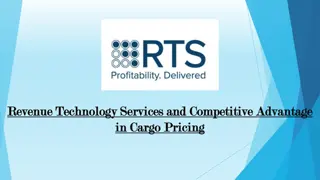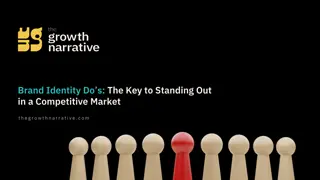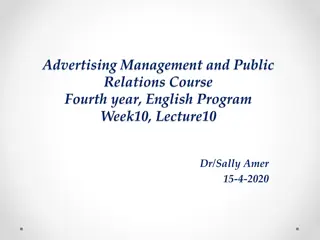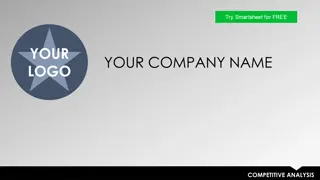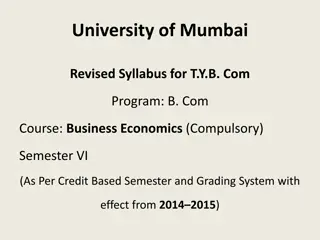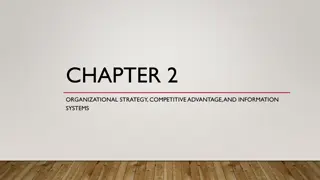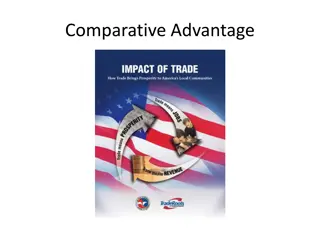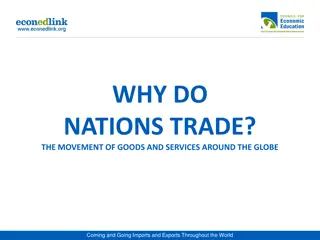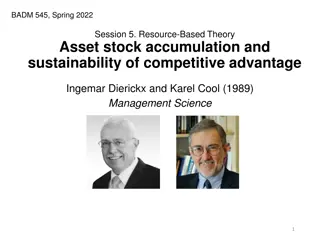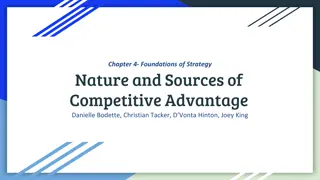Creating Competitive Advantage with Competitor Analysis
Unlock the power of competitor analysis to gain a strategic advantage. Learn how to assess competitors' objectives, strategies, strengths, and weaknesses to position your company effectively in the market. Discover different forms of competition, strategic groupings, and Porter's approach for analyzing competitive structures in this insightful session outline.
Download Presentation

Please find below an Image/Link to download the presentation.
The content on the website is provided AS IS for your information and personal use only. It may not be sold, licensed, or shared on other websites without obtaining consent from the author.If you encounter any issues during the download, it is possible that the publisher has removed the file from their server.
You are allowed to download the files provided on this website for personal or commercial use, subject to the condition that they are used lawfully. All files are the property of their respective owners.
The content on the website is provided AS IS for your information and personal use only. It may not be sold, licensed, or shared on other websites without obtaining consent from the author.
E N D
Presentation Transcript
Creating Competitive Advantage Dr. Amila Jayarathne
Session Outline Competitor Analysis Competitive Strategies Balancing Customer and Competitor Orientations
Competitor Analysis Competitive Advantage An advantage over competitors gained by offering consumers greater value than competitors do. Competitor Analysis The process of identifying key competitors; assessing their objectives, strategies, strengths and weaknesses, and reaction patterns; and selecting which competitors to attack or avoid. Competitive Marketing Strategies Strategies that strongly position the company against competitors and that give the company the strongest possible strategic advantage.
Why? To plan effective marketing strategies the company needs to find out all it can about its competitors. It must constantly compare its marketing strategies, products, prices, channels, and promotions with those of close competitors. Steps in Analyzing Competitors Assessing competitors objectives, strategies, strengths and weaknesses and reaction patterns Identifying the company s competitors Selecting which competitors to attack or avoid.
Identifying Competitors Normally, identifying competitors would seem a simple task. But companies actually face a much wider range of competitors. Companies must avoid competitor myopia.
Different Forms of Competition Brand Competition Industry Competition Form Competition Generic Competition
Assessing Competitors Determining Competitors Objectives Identifying Competitors Strategies Identifying Competitors Strategies Assessing Competitors Strengths and Weaknesses Estimating Competitors Reactions
Strategic Groups A group of firms in an industry following the same or a similar strategy. A group of firms in an industry following the same or a similar strategy.
Selecting Competitors to Attack and Avoid Strong or weak competitors Close or distant competitors Close or distant competitors Good or bad competitors
Strong or Weak Competitors The company can focus on one of several classes of competitors. A useful tool for assessing competitor strengths and weaknesses is customer value analysis. Customer Value Analysis Analysis conducted to determine what benefits target customers value and how they rate the relative value of various competitors offers. Customer Value Analysis Analysis conducted to determine what benefits target customers value and how they rate the relative value of various competitors offers.
Strategic Sweet Spot versus Competitors Customers needs Competitors offerings Sweet spot When competitors, company wants to find the sweetspot where it customers needs in a way that rivals can t. selecting the Company s capabilities meets
Good or Bad Competitors A company really needs and benefits from competitors. However, a company may not view all of its competitors as beneficial. Good competitors play by the rules of the industry. Bad competitors, in contrast, break the rules.
Finding Uncontested Market Spaces Rather than competing head to head with established competitors, many companies seek out unoccupied positions in uncontested market spaces (No direct competitors) Blue Ocean Strategy.
Designing a Competitive Intelligence System Main types of information about competitors must be collected, interpreted, distributed and used.
Competitive Strategies What broad marketing strategies might the company use? Which ones are best for a particular company, or for the company s different divisions and products?
Approaches to Marketing Strategy No one strategy is best for all companies. Each company must determine what makes the most sense given its position in the industry and its objectives, resources. opportunities and
Basic Competitive Strategies Overall Cost Leadership Differentiation Focus
Competitive Positions Competitive Market Positions and Roles Market Leader Market Challenger Market Follower Market Nicher 40% 30% 20% 10%
Market Leader Strategies Market Leader The firm in an industry with the largest market share. Expand Total Market Protect Market Share Expand Market Share
Market Challenger Strategies Market Challenger A runner-up firm that is fighting hard to increase its market share in an industry. Full Frontal Attack Indirect Attack
Market Follower Strategies Market Follower A runner-up firm that wants to hold its share in an industry without rocking the boat. Follow at a Distance
Market Nicher Strategies Market Nicher A firm that serves small segments that the other firms in an industry overlook or ignore. By Customer, Market, Quality-Price, Service Multiple Niching
Balancing Customer and Competitor Orientations Can the company spend too much time and energy tracking competitors, damaging its customer orientation?
Evolving Company Orientations Customer-Centered Yes No Competitor-Centered Product Orientation Customer Orientation No Competitor Orientation Market Orientation Yes





